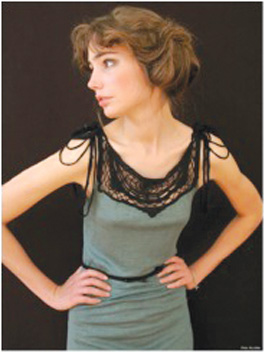home | north bay bohemian index | features | north bay | green zone
From ABBA to 'Eco Chic'
'Gron Mode' proves Sweden still rocks (the boat)
By Juliane Poirier

The generation that missed ABBA (mamma mia!) seems nevertheless to have welcomed, open-armed, all the Swedish-designed interiors and furnishings that money can buy. IKEA appears to have a magnetic aesthetic in the Bay Area. But will fans of the modern Scandinavian look still feel pulled toward Swedish chic if it means looking hard at what's behind the scenes of the global fashion industry? The West Coast premiere of "Gron Mode" ("Green Fashion"), aka "Eco Chic: Towards Sustainable Swedish Fashion," opens Feb. 19 at the Sonoma Valley Museum of Art, just off the historic square in the town of Sonoma. A sneak peek has convinced me the new Swedish clothes designs are smart and beautiful.
But this fashion show is not just about appearances.
Anyone eager to try on this new green line will also have to try on the relatively foreign concept of green fashion ethics. Kate Eilertsen tried on the concept and found a fit. As executive director, Eilertsen wants the "Eco Chic" exhibit to challenge and educate people about what is possible and sustainable in terms of humane, nonpolluting garment-manufacturing practices, and also to raise consciousness about the wastefulness in our everyday clothing-use habits. The clothes that visitors will see piled in the storefront window of the museum are neither the Swedish imports nor somebody's dirty laundry; rather, the small mountain of garments represents the 68 pounds of clothing each person discards every year in this country.
"I have a 25-year-old daughter," explains Eilertsen, "who discovered H&M and all of those fast-food-type clothing stores, where you buy it cheap, wear it a few times and then throw it away." Eilertsen says her daughter's fashion habits influenced her decision to bring "Eco Chic" to California, following its exhibition in Europe and New York. And it's "not just my daughter, but all her friends," says Eilertsen, who believes the Swedish fashion designers and manufacturers are taking a deep look at an ostensibly shallow industry and stripping away the most unethical elements such as exploitative labor practices and the purchase of materials from environmentally irresponsible suppliers.
"High fashion in a sustainable manner means thoughtfully sourcing your materials and dyes," explained Eilertsen. "And it means constructing the clothes in an ethical workplace, not a sweat shop." In a document issued by the museum, Eilertsen notes that "fashion-related businesses have been accused of destroying natural habitats, using more water than any other industry apart from agriculture, spreading toxic chemicals and producing carbon dioxide emissions" as well as participating in the common business practice of exploiting labor in poor countries.
A 2007 report by Luz Claudio of the National Institute of Environmental Health Sciences reports that for the roughly 1 billion garments made in China and purchased by U.S. consumers—
4 garments per U.S. citizen—workers make 12 to 15 cents per hour in poor working conditions. China is one of the world's largest producers of jeans. In "Waste Couture: Environmental Impact of the Clothing Industry," Claudio concludes that despite all the industry can do to improve, "the biggest impacts for increasing sustainability in the clothing industry rests with the consumer."
The selected Swedish clothing designers and manufacturers featured in the "Eco Chic" exhibit boast a very different business ethic. Designer Anja Hynynen claims the use of "only materials that are organically grown and ethically produced," while Camilla Norrback says of her Ecoluxury clothing that wearers can "feel both beautiful and proud."
The Sri Lankan workers who construct clothing designed by members of the Dem Collective are paid three times the national minimum wage, while clothing from the Julian Red label boasts that "fair and organic production is reflected in all its production." Finally, the makers of Nudie Jeans boast a code of conduct "based on the U.N. Declaration of Human Rights" and a policy to work exclusively with democracies.
Other ways to "feel both beautiful and proud" might include participating in a slow food event, a clothing swap and classes tied to the "Eco Chic" exhibit.
'Eco Chic,' along with 'Daniel McCormick: Iterations of Ecological Art and Design,' runs Feb. 19-May 15 at the Sonoma Valley Museum of Art. 551 Broadway, Sonoma. Wednesday-Sunday, 11am-5pm. $5. 707.939.7862.
Send a letter to the editor about this story.
|
|
|
|
|
|